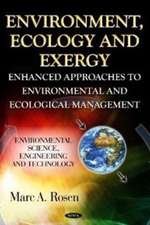Limnological Analyses
Autor Robert G. Wetzel, Gene E. Likensen Limba Engleză Paperback – dec 2010
| Toate formatele și edițiile | Preț | Express |
|---|---|---|
| Paperback (1) | 540.41 lei 43-57 zile | |
| Springer – dec 2010 | 540.41 lei 43-57 zile | |
| Hardback (1) | 716.80 lei 43-57 zile | |
| Springer – 3 mar 2000 | 716.80 lei 43-57 zile |
Preț: 540.41 lei
Preț vechi: 635.79 lei
-15% Nou
Puncte Express: 811
Preț estimativ în valută:
103.40€ • 108.25$ • 85.56£
103.40€ • 108.25$ • 85.56£
Carte tipărită la comandă
Livrare economică 07-21 aprilie
Preluare comenzi: 021 569.72.76
Specificații
ISBN-13: 9781441931863
ISBN-10: 1441931864
Pagini: 448
Ilustrații: XV, 429 p.
Dimensiuni: 178 x 254 x 24 mm
Greutate: 0.78 kg
Ediția:Softcover reprint of hardcover 3rd ed. 2000
Editura: Springer
Colecția Springer
Locul publicării:New York, NY, United States
ISBN-10: 1441931864
Pagini: 448
Ilustrații: XV, 429 p.
Dimensiuni: 178 x 254 x 24 mm
Greutate: 0.78 kg
Ediția:Softcover reprint of hardcover 3rd ed. 2000
Editura: Springer
Colecția Springer
Locul publicării:New York, NY, United States
Public țintă
GraduateCuprins
Exercise 1 Lake Basin Characteristics and Morphometry.- Exercise 2 Light and Temperature.- Exercise 3 Physical Characteristics: Lake Models.- Exercise 4 The Heat Budget of Lakes.- Exercise 5 Morphology and Flow in Streams.- Exercise 6 Dissolved Oxygen.- Exercise 7 Inorganic Nutrients: Nitrogen, Phosphorus, and Other Nutrients.- Exercise 8 The Inorganic Carbon Complex: Alkalinity, Acidity, CO2, pH, Total Inorganic Carbon, Hardness, Aluminum.- Exercise 9 Organic Matter.- Exercise 10 Composition and Biomass of Phytoplankton.- Exercise 11 Collection, Enumeration, and Biomass of Zooplankton.- Exercise 12 Benthic Fauna of Lakes.- Exercise 13 Benthic Fauna of Streams.- Exercise 14 Primary Productivity of Phytoplankton.- Exercise 15 Feeding Rates by Protists and Larger Zooplankton.- Exercise 16 Zooplankton Production.- Exercise 17 Predator-Prey Interactions.- Exercise 18 Enumeration of Fish or Other Aquatic Animals.- Exercise 19 Bacterial Growth and Productivity.- Exercise 20 Decomposition: Relative Bacterial Heterotrophic Activity on Soluble Organic Matter.- Exercise 21 Decomposition: Particulate Organic Matter.- Exercise 22 The Littoral Zone.- Exercise 23 Experimental Manipulation of Model Ecosystems.- Exercise 24 Diurnal Changes in a Stream Ecosystem: An Energy and Nutrient Budget Approach.- Exercise 25 Diurnal Changes in Lake Systems.- Exercise 26 Special Lake Types.- Exercise 27 Historical Records of Changes in the Productivity of Lakes.- Exercise 28 Effect of Sewage Outfall on a Stream Ecosystem.- Exercise 29 Estimates of Whole Lake Metabolism: Hypolimnetic Oxygen Deficits and Carbon Dioxide Accumulation.- Appendix 1 General Chemical Relationships.- Appendix 2 Basic Definitions Used in Community Analyses.- Appendix 3 Useful Relationships Relative to the Use of Colorimeters and Spectrophotometers.- Appendix 4 Characteristics and Taxonomic Sources of Common freshwater Organisms.- Appendix 5 SI Conversion Factors.
Recenzii
From the reviews of the third edition:
"Designed to accommodate undergraduates with diverse backgrounds, this text provides an excellent introduction to limnological methods and problems. … In other words, this book was written to be used in the classroom, the laboratory, and the field! … Many line drawings, graphs, and B/W photographs provided. Amply referenced, this book should be considered by professional limnologists, especially those looking for an excellent undergraduate textbook." (Northeastern Naturalist, Vol. 12 (2), 2005)
"This is the third edition of this well known text book on limnological methods. … This book is written for students but also for the teachers and is meanwhile a standard volume … and a starting point for independent scientific work. Without doubt all students and teachers should have access to this book. … I would recommend that if you already do not have this book, it is worth more than ever to buy it." (Norbert Walz, International Review of Hydrobiology, Vol. 86 (1), 2001)
"Designed to accommodate undergraduates with diverse backgrounds, this text provides an excellent introduction to limnological methods and problems. … In other words, this book was written to be used in the classroom, the laboratory, and the field! … Many line drawings, graphs, and B/W photographs provided. Amply referenced, this book should be considered by professional limnologists, especially those looking for an excellent undergraduate textbook." (Northeastern Naturalist, Vol. 12 (2), 2005)
"This is the third edition of this well known text book on limnological methods. … This book is written for students but also for the teachers and is meanwhile a standard volume … and a starting point for independent scientific work. Without doubt all students and teachers should have access to this book. … I would recommend that if you already do not have this book, it is worth more than ever to buy it." (Norbert Walz, International Review of Hydrobiology, Vol. 86 (1), 2001)












